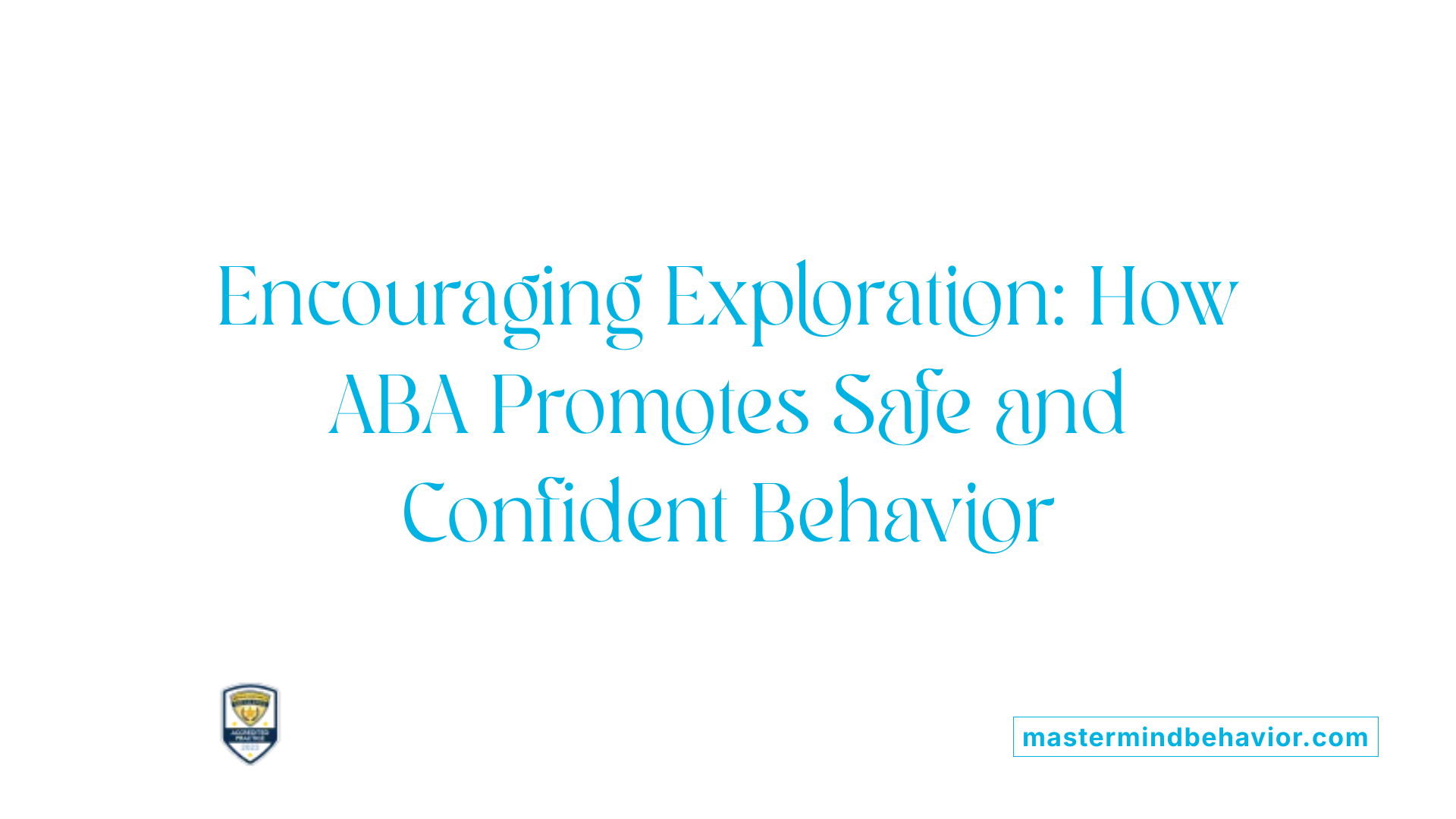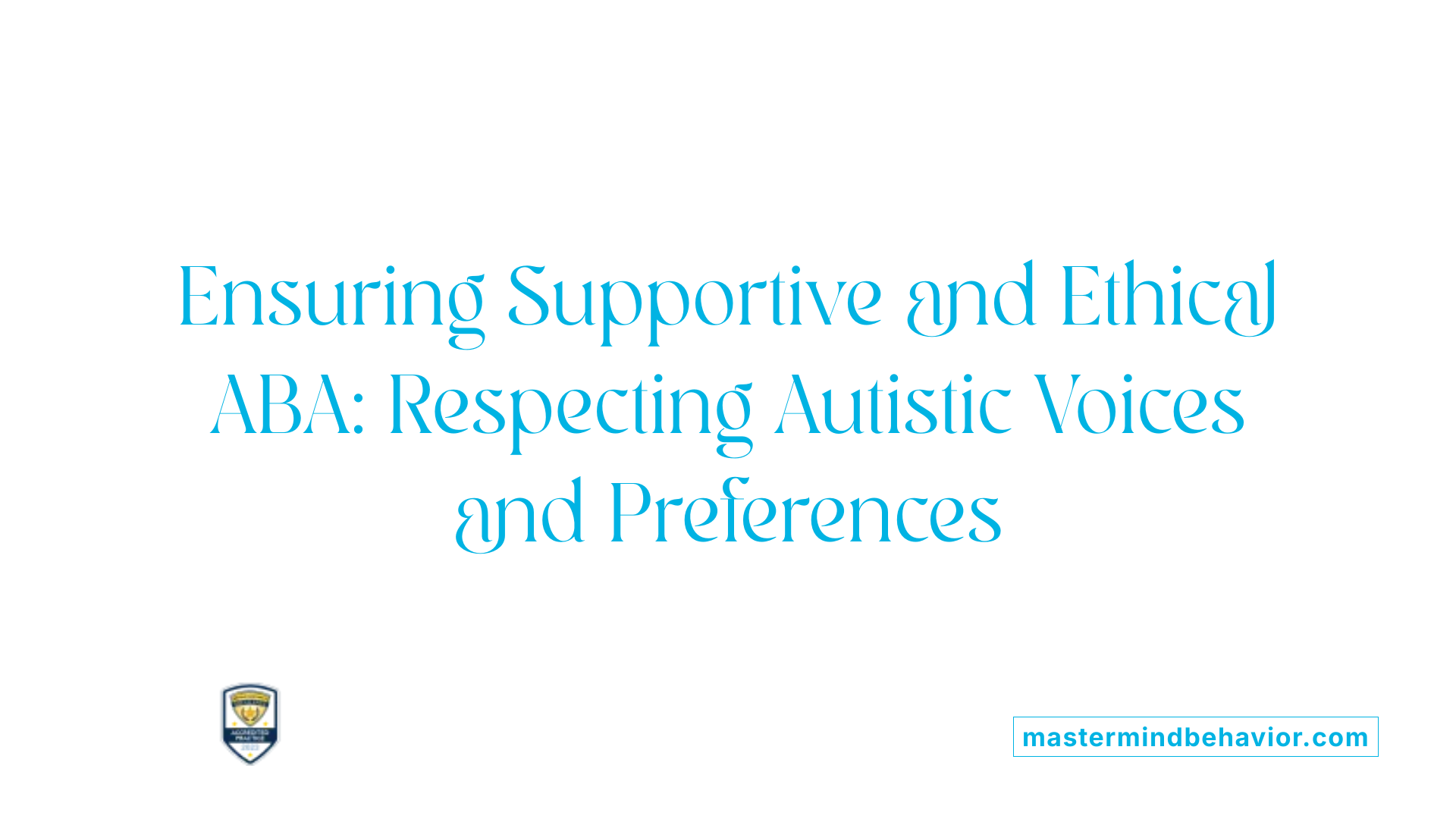Understanding the Role of ABA Therapy in Encouraging Safe Exploration
Applied Behavior Analysis (ABA) therapy is widely recognized as a scientifically grounded approach for supporting individuals with autism spectrum disorder (ASD) in acquiring vital life skills. Among its many benefits, ABA therapy plays a pivotal role in encouraging safe risk-taking within community settings, which is essential for fostering independence, social integration, and confidence. This article explores how ABA therapy’s principles and strategies enable autistic individuals to navigate the complexities of real-world environments while minimizing risks and promoting personal growth.
Foundations of ABA Therapy in Autism Treatment
What is Applied Behavior Analysis (ABA) therapy and how is it used in treating autism?
Applied Behavior Analysis (ABA) therapy is a science-based method focused on understanding and modifying behavior by examining its interaction with the environment. It aims to increase positive behaviors such as communication and social skills, while reducing harmful or challenging behaviors. ABA employs the ABC model, which analyzes the Antecedent (trigger), Behavior, and Consequence to create strategies that promote desirable responses.
Individualized treatment approaches
ABA therapy is highly personalized. Therapists conduct thorough initial evaluations and collaborate with families to develop treatment plans tailored to the individual's needs, strengths, and interests. This individualized approach ensures that the therapy addresses specific developmental goals, like improving language, social, and daily living skills.
Use of behavioral techniques such as the ABC model and positive reinforcement
The ABC (Antecedent-Behavior-Consequence) model guides therapists in identifying triggers and consequences of behaviors to adjust treatments effectively. Positive reinforcement is central, where desirable behaviors are encouraged through rewards, promoting lasting behavioral improvements.
Settings where ABA therapy is delivered
ABA therapy is adaptable and delivered across various settings including the home, school, and community environments. Properly trained therapists, parents, or caregivers can implement ABA strategies, ensuring consistent reinforcement of skills across different contexts, thus enhancing generalization and practical use of learned behaviors.
Who Provides ABA Therapy and How Is It Delivered?

Who typically provides ABA therapy services for individuals with autism?
ABA therapy is usually delivered by qualified and licensed professionals who hold certifications such as Board Certified Behavior Analysts (BCBAs). Other trained providers include psychologists, social workers, and specialized therapists with expertise in behavioral analysis. These professionals design and implement personalized treatment plans that align with the individual's age, strengths, and needs.
In what settings is ABA therapy delivered?
ABA therapy can be offered in multiple environments to support consistent skill development. Common settings include the child's home, school, or community spaces. Flexibility in location helps generalize skills across daily routines, increasing practical benefits.
How do providers collaborate with families and caregivers?
Effective ABA therapy emphasizes collaboration with families and caregivers through regular communication and involvement in goal setting. Therapists conduct comprehensive evaluations and develop individual treatment goals incorporating family input. Families often receive training to support skill reinforcement outside formal sessions.
What role does parent training and interdisciplinary support play?
Parent training is crucial for extending therapy benefits beyond clinical hours. Training equips caregivers with techniques like positive reinforcement and behavior prompting. Additionally, ABA programs often integrate support from speech and language therapists, occupational therapists, and psychologists, forming an interdisciplinary team that addresses broader developmental needs to enhance overall outcomes.
Promoting Safe Risk Taking Through ABA Strategies

How Does Positive Reinforcement Encourage Exploring New Behaviors?
Positive reinforcement is a cornerstone of Applied Behaviour Analysis (ABA) and plays a vital role in encouraging individuals, especially autistic children, to explore new behaviors safely. By rewarding desirable actions, therapists help increase the likelihood these behaviors will be repeated. This approach gently motivates individuals to try new activities or social interactions in a positive, supportive environment, fostering confidence and skill development while minimizing fear or anxiety.
How Is the ABC Model Applied to Assess and Manage Risks?
The ABC model (Antecedent-Behavior-Consequence) in ABA helps therapists identify what triggers a potentially risky behavior, how the individual responds, and what consequences follow. Understanding these elements allows for targeted intervention strategies to manage and reduce unsafe behaviors while promoting safer alternatives. This model enables careful monitoring and modification of behavior to encourage safe exploration of new experiences and environments.
How Does ABA Teach Behavioral Management and Social Cues for Safe Community Interaction?
ABA therapy incorporates teaching behavioral management skills along with decoding social cues to facilitate safe and positive interactions within community settings. This includes helping individuals recognize social signals, respond appropriately, and practice strategies for emotional regulation. Such training supports autistic learners in navigating social expectations, reducing misunderstandings, and increasing successful community participation.
What is the Role of Gradual Exposure to Community Settings?
Gradual exposure is used within ABA to ease individuals into new or challenging community environments. Starting with structured, low-stress visits and progressively increasing the complexity and duration helps reduce anxiety and build comfort. Therapists and caregivers use this step-by-step approach to ensure the individual feels safe and supported while expanding their experiences.
What Strategies Does ABA Use to Reduce Anxiety During Unstructured Times?
Unstructured times can provoke anxiety in autistic individuals. ABA often develops personalized schedules and predictable routines to minimize stress during these moments. Using clear expectations and visual supports, the therapy provides a framework that reduces uncertainty, promoting engagement and calmness.
| Strategy | Purpose | Description |
|---|---|---|
| Positive Reinforcement | Encourage new behaviors | Rewarding desirable actions to increase repetition |
| ABC Model | Assess and manage risks | Analyzing triggers, behaviors, and outcomes to guide interventions |
| Behavioral Management & Social Cues | Safe community interaction | Teaching how to recognize and respond to social signals |
| Gradual Exposure | Build comfort in community | Stepwise introduction to new settings to reduce anxiety |
| Personalized Schedules | Reduce anxiety in unstructured times | Creating routines and clear expectations to minimize stress |
Early Intervention and Its Impact on Community Integration
Why is early and intensive ABA therapy important?
Early intervention with Applied Behaviour Analysis (ABA) therapy is crucial for children with autism spectrum disorder (ASD). Starting therapy as early as possible, often before age six, allows children to develop essential communication and social skills during critical developmental windows. Intensive therapy, involving frequent sessions tailored to the child's unique needs, maximizes skill acquisition and behavioral improvements.
How does ABA therapy improve communication, social skills, and adaptive behaviors?
ABA uses evidence-based strategies like positive reinforcement and direct instruction to teach language development, social interaction, and daily living skills. Techniques such as discrete trial training and pivotal response training help increase desirable behaviors while reducing harmful ones. These methods improve expressive language, social engagement, and self-care abilities, fostering more effective communication and socialization.
How does building foundational skills support social independence?
Early ABA therapy teaches fundamental behaviors that act as building blocks for more complex skills. For example, mastering simple communication and adaptive routines supports greater autonomy in daily activities, such as dressing or using the bathroom. These foundational skills promote self-confidence and preparedness for diverse environments.
How does early teaching support later complex community interactions?
By developing basic communication and social skills early, ABA therapy prepares children to engage successfully in more complex social settings like school and community activities. Improved behavioral management and social understanding enable autistic individuals to interpret social cues and form meaningful relationships, enhancing community integration and overall quality of life.
Measuring the Effectiveness of ABA Therapy in Real-World Settings
How is the effectiveness of ABA therapy measured?
The effectiveness of ABA therapy is assessed through standardized behavioral assessments that monitor progress in key areas like communication, social skills, and adaptive behaviors. For example, tools such as the Skills assessment help quantify improvements in these domains over time.
Use of standardized behavioral assessments
Standardized assessments are crucial for collecting reliable and valid data on each individual's development. These tools allow therapists to track specific behaviors accurately and compare progress across different sessions and providers.
Tracking progress in communication, social, and adaptive skills
Clinicians use the collected data to evaluate gains in language acquisition, social interaction, and daily living skills. This objective tracking helps in understanding how well the therapy supports a person’s needs in practical areas.
Adjusting treatment based on objective data
Therapists analyze assessment results regularly to tailor treatment plans. Changes in strategies or focus areas are implemented to optimize outcomes, ensuring the therapy remains aligned with the individual's evolving needs.
Correlation between therapy intensity and outcomes
Research indicates that the amount and intensity of ABA therapy directly impact its effectiveness. Increased therapy hours often result in greater improvements, with significant effect sizes observed, explaining large portions of outcome variations.
This structured approach to measuring and adjusting ABA therapy efficacy confirms its role in evidence-based practice and highlights the importance of data-driven care for autistic individuals.
Addressing Ethical Considerations and Controversies in ABA

Historic versus Modern ABA Practices
Applied Behavior Analysis (ABA) has evolved significantly over time. Historically, some ABA methods included severe and punitive techniques such as electric shocks, which are now universally condemned. Modern ABA focuses on positive reinforcement and tailored behavioral strategies, emphasizing ethical treatment and individualized care.
Importance of Person-Centered Approaches
A central tenet of contemporary ABA and Positive Behaviour Support (PBS) is working collaboratively with the individual and their support network to understand needs and distress causes. Person-centered approaches prioritize the autistic person's unique strengths and preferences, aiming to improve safety and happiness rather than enforcing conformity.
Avoiding Punitive and Harmful Techniques
Ethical ABA practice rejects any intervention that employs punishment or seeks to suppress natural autistic behaviors like stimming. Such punitive techniques are harmful and can lead to negative outcomes including mental health challenges and trauma. Instead, focus is on supportive, non-restrictive strategies that promote well-being.
Recognition of Autistic Perspectives on Therapy
Many autistic self-advocates express concern about ABA's historic focus on reducing behaviors perceived as undesirable, stressing potential trauma caused by some interventions. Incorporating autistic voices in therapy design and evaluation ensures respectful and meaningful support aligned with individual needs.
Use of Ethical Guidelines to Ensure Safe, Supportive Care
Professional consensus emphasizes implementing ABA ethically and sensitively. Guidelines encourage positive reinforcement, ongoing evaluation, and avoiding harm. When applied responsively and collaboratively, ABA can enhance quality of life, helping individuals develop useful skills while respecting their identity.
| Aspect | Historic ABA Practices | Modern ABA and PBS | Ethical Focus |
|---|---|---|---|
| Techniques | Included punitive methods like electric shocks | Positive reinforcement, individualized plans | Avoid punishment, focus on support |
| Individual-Centered Approach | Often lacked full collaboration with individuals | Emphasis on person-centered, collaborative work | Respects autistic identity and preferences |
| Autistic Perspectives | Historically overlooked or minimized | Actively incorporated for informed therapy | Ensures therapy aligns with lived experiences |
| Outcomes | Sometimes caused trauma and mental health issues | Aims to reduce anxiety, enhance life skills | Promotes well-being and autonomy |
Integrating ABA Therapy with Other Support Approaches for Community Success
Collaborative Work with Occupational, Speech, and Psychological Therapies
ABA therapy is often integrated with other specialist supports such as occupational, speech, and psychological therapies. This collaborative model ensures that interventions are tailored to the individual’s unique profile, addressing communication, sensory processing, emotional regulation, and cognitive skills. Working alongside professionals from these disciplines allows therapists to create comprehensive plans promoting holistic development.
Role of Positive Behavioral Support (PBS) to Reduce Anxiety and Distress
Positive Behavioral Support (PBS) focuses on understanding the causes of distress by engaging both the individual and their support network. PBS employs personalized schedules and environmental adjustments to reduce anxiety, particularly during unstructured times. When combined with ABA, PBS contributes to managing challenging behaviors through non-punitive, person-centered strategies that prioritize well-being over mere behavior modification.
Combining Skill Development with Emotional Wellbeing
ABA’s evidence-based techniques such as discrete trial training and pivotal response training are used alongside PBS strategies to nurture essential life and communication skills while also supporting emotional health. This approach recognizes that skill acquisition must occur in an environment where anxiety and distress are minimized, facilitating more sustainable developmental gains and improved quality of life.
Whole-Person Approach to Promote Safety and Happiness in Community Participation
The integration of ABA with PBS and allied therapies exemplifies a whole-person approach that promotes both safety and happiness. By addressing behavioral, emotional, and social dimensions collectively, this model enhances an individual’s capability to participate confidently and safely in community settings. It underscores the importance of ethical, supportive, and individualized interventions to foster independence and fulfillment within society.
Encouraging Empowerment Through Ethical ABA in Community Environments
ABA therapy, when delivered ethically and thoughtfully by skilled professionals, equips autistic individuals with vital skills that encourage safe risk-taking and successful navigation of community settings. Grounded in positive reinforcement and personalized strategies, ABA supports communication, social interaction, and daily living skills, fostering independence and confidence. Its integration with approaches like Positive Behavioral Support ensures reduced anxiety and greater emotional regulation, further empowering individuals to embrace new experiences safely. Moving forward, ongoing research, adherence to ethical standards, and inclusion of autistic voices remain essential to refining ABA therapy, ensuring it remains a supportive tool that respects individuality while promoting growth and community inclusion.
References
- Positive Behaviour Support (PBS)
- Applied Behavior Analysis Provided Via Telehealth Evidence ...
- How to Treat Autism Using Applied Behavior Analysis
- 6 Benefits of ABA Therapy for Children with Autism
- Is ABA therapy harmful? The controversy explained
- BHCOE Gives Autism Field a Needed Boost in Measuring ...
- An evaluation of the effects of intensity and duration on ...
- Applied Behavior Analysis (ABA)









